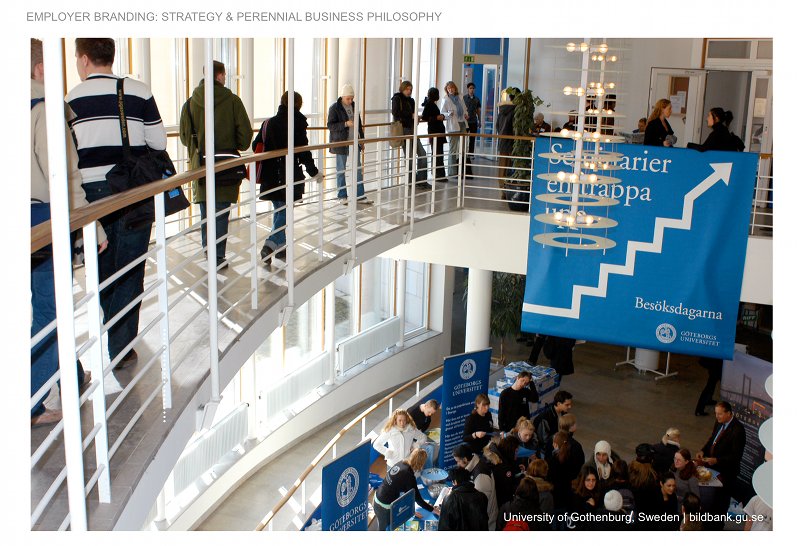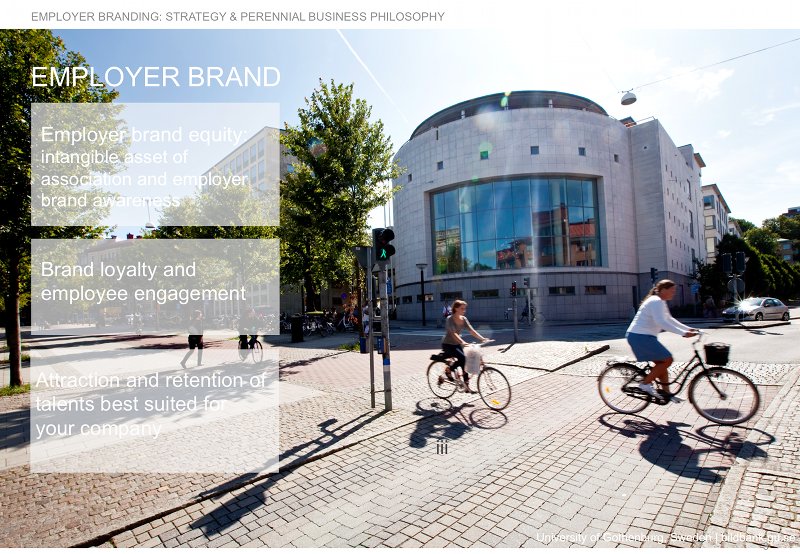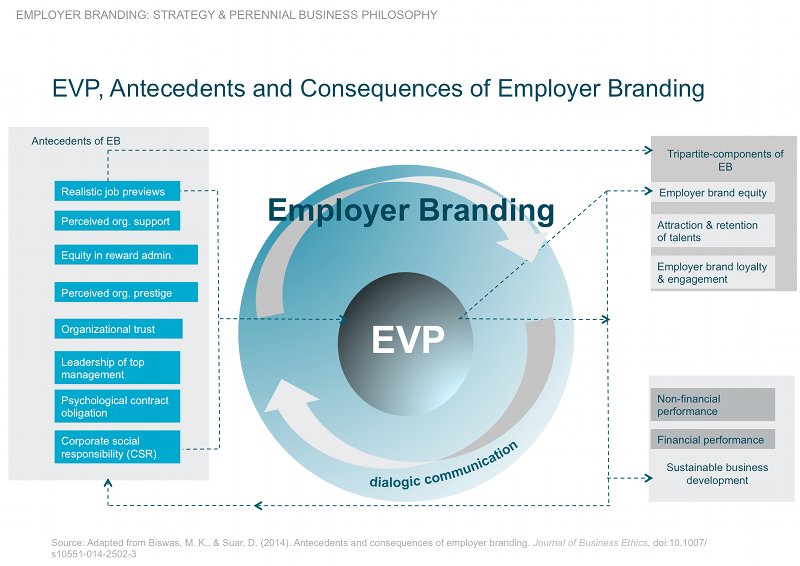Text © CM Cordeiro, Sweden 2015
The professional sphere increasingly views talent as a primary competitive enabler of a business. As more companies expand globally and shift their focus to high-growth regions, they face a growing skills and talent gaps for a variety of reasons [1]. People, are increasingly seen as a source of competitive advantage, where without the appropriate talent pool, the business might just not be a success [2,3].
Many employers therefore adopt various strategies to maintain a healthy talent pool. One such strategy, employer branding or EB, is a critical tool for talent acquisition, development and retention [4-7] in which companies begin first to focus on building an employer brand.
An employer brand refers to a general recognition for being known among key stakeholders for providing a high-quality employment experience, and a distinctive organizational identity which employees value, engage with and feel confident / happy to promote to others [8]. It consists of the tri-components of:
(i) an employer brand equity, which is the intangible asset of association and employer brand awareness among existing and potential employees.
(ii) Brand loyalty and employee engagement
(iii) Attraction and retention of talents best suited for your company
The distinct rise in interest in EB not just in practice but also in the academic field [9] much due to the global dynamics and evolution of the talent market, such as the changing values of young professionals who today prefer jobs that can give them a work-life balance [10, 11]. This shift towards increasing focus on employee engagement, the acute competition for appropriate talent for the company, and the impact of HR practices on business [2,9] have also been cited as reasons for the rise in EB.
While the above HR focused EB strategy relates to the interior of the organization, EB also has an exterior facing component that addresses how potential employees might view the company. This realization has come about mostly through the proven impact of consumer branding. If companies can relate to how the product branding has had an effect on consumption patterns, from fulfilling basic infrastructural needs such as shoes for walking, to marking social and economic status, anywhere in the range of collectible Nikes to Prada or Gucci shoes, then an employer brand is that distinctive, identifiable, unique employer identity that differentiates the company from its competitors [4].
The employer brand differentiation and an orientation towards the successful managing of the interior-exterior dialogic communication of the company have its economic influences.
In the professional sphere, a study by the Boston Consulting Group in 2012 [2], that conducted 63 deep interviews with leading business and HR executes across the globe on top of polling over 4,000 executives, indicate that economic influence is discernable by having an integrated HR strategy, where EB was ranked as the top six most pronounced strategy to have positive financial advantages for companies. When it comes to EB, more capable companies outperform competitors by 2.4x revenue growth and 1.8x profit margin increase. Gallup 2013 also reported that work units who engaged employees saw “significantly lower turnover (25% in high-turnover organizations, 65% in low-turnover organizations), shrinkage (28%), and absenteeism (37%) and fewer safety incidents (48%), patient safety incidents (41%), and quality defects (41%).” [12]
Because of the bi-directional dialogical influence of what an employer brand entails, EB is not only seen as a strategy, but a business philosophy.
Exteriorly, a strong employer brand entails the power to influence in attracting the type of individuals needed for the continued development of the company and interiorly. Interiorly, a strong employer brand builds psychological contracts with the employees based on trust. The affiliation the employees feel towards the company then results in a lower turnover rate. When employees are engaged, attendance is strong, thereby increasing profit per employee and creating high return on investment (RoI) [2,9,12].
EB as a strategy and business philosophy render a long-term perspective of development for the company, a result of which is lower cost per hire for the company. In fact, cost per hire is more than twice as low for companies with strong employer brands, since what has been created is a company talent magnet culture [2]. In that sense, mastering the art of effective EB communication bi-directionally helps create an autopoietic system, a self-generating system of the values from within the organization being able to attract, generate and retain a likewise unique pool of talent.
Companies begin building their employer brand by defining their Employer Value Proposition or EVP. The EVP is the core of an employer brand. It refers to the marketability of attributes of company that includes both the financial and non-financial offerings to targeted employees [9, 13-15]
I have adapted the above figure from Biswas and Suar (2014), modifying it to illustrate in one diagram, the concept of EB, with the EVP at its core. The antecedents as defined by Biswas and Suar (2014) are found to the left side of the diagram, and the tri-components of an employer brand at the top right. The consequences of EB that includes a perennial business philosophy of having created a sustainable business with a strong EVP and EB is found to the bottom left of the figure.
EB as a field of study in academia has some interesting potentials, much due to that current practice trends indicate that it is not only the bi-directional dialogic communication of an employer brand that companies will need to manage in future, but one that is aligned with its consumer branding communication [16-18].
Based on these findings, EB is a proactive business strategy and a perennial philosophy towards a company’s genuine interest in attracting talent specifically catered to the needs of the company. All companies have an employer brand. It is only a matter to define, operationalize and communicate better that clear inner vision.
An artful bi-directional dialogic communication, supported by company policies and practices will in time, create that talent magnet culture set in an autopoetic system that will see its sustainable development and RoIs.
—
For a different perspective on branding in general, where branding compared to content is viewed as empty and a poor investment in the lack of authenticity, read Lotta Lundberg’s chronicle in Svenska Dagbladet, 26 March 2015, entitled När pengar läggs på ord hellre än omsorg.
References
[1] Chambers, E. G., Foulon, M., Handfield-Jones, H., Hankin, S. M., & Michaels, E. G. I. I. I. (1998). The war for talent. The McKinsey Quarterly, 3, 44–57.
[2] BCG 2012. Creating people advantage 2012: Mastering HR challenges in a two-speed world. Boston Consulting Group. Internet resource at http://bit.ly/1Nc8efZ. Retrieved 27 March 2015.
[3] ibid [1]
[4] Backhaus, K., & Tikoo, S. (2004). Conceptualising and researching employer branding. Career Development International, 9(5), 501–517.
[5] Barrow, S., & Mosley, R. (2005). The employer brand: Bringing the best of brand management to people at work. New York: Wiley.
[6] Gaddam, S. (2008). Modeling employer branding communication: The softer aspect of HR marketing management. The ICFAI Journal of Soft Skills, 2(1), 45–55.
[7] Mandhanya, Y., & Shah, M. (2010). Employer branding: a tool for talent management. Global Management Review, 4(2), 43–48.
[8] Martin, G., Gollan, P. J., & Grigg, K. (2011). Is there a bigger and better future for employer branding? Facing up to innovation, corporate reputations and wicked problems in SHRM. International Journal of Human Resource Management, 22(17/11), 3618–3637.
[9] Biswas, M. K., & Suar, D. (2014). Antecedents and consequences of employer branding. Journal of Business Ethics, doi:10.1007/s10551-014-2502-3
[10] Esser, P. (2007). Why gen Y matters. Multichannel News, 28(50), 42.
[11] Grant, D. (2013). Bringing on gen Y: Younger planners have their own priorities. if you’re investing in their professional development, consider these ideas to ensure they will stick around. New York: SourceMedia.
[12] Sorenson, S. (2013). How employee engagement drives growth, Gallup 2013. Internet resource at http://bit.ly/1xpMvfT. Retrieved 27 March 2015.
[13] Corporate Leadership Council. (1999). The employer brand: Building competitive advantage in the labour market. Washington, D. C: Corporate Leadership Council.
[14] Corporate Leadership Council. (2004). Driving performance and retention through employee engagement. Washington, D. C: Corporate Leadership Council.
[15] Sartain, L., & Schuman, M. (2006). Brand from the inside: Eight essentials to emotionally connect your employees to your business. San Francisco, CA: Jossey-Bass.
[16] Moroko, L., & Uncles, M. D. (2008). Characteristics of successful employer brands. Journal of Brand Management, 16(3), 160–175.
[17] Moroko, L., & Uncles, M. D. (2009). Employer branding and market segmentation. Journal of Brand Management, 17(3), 181–196.
[18] Mosley, R. (2007). Customer experience, organisational culture and the employer brand. Brand Management, 15(2), 123–134.



